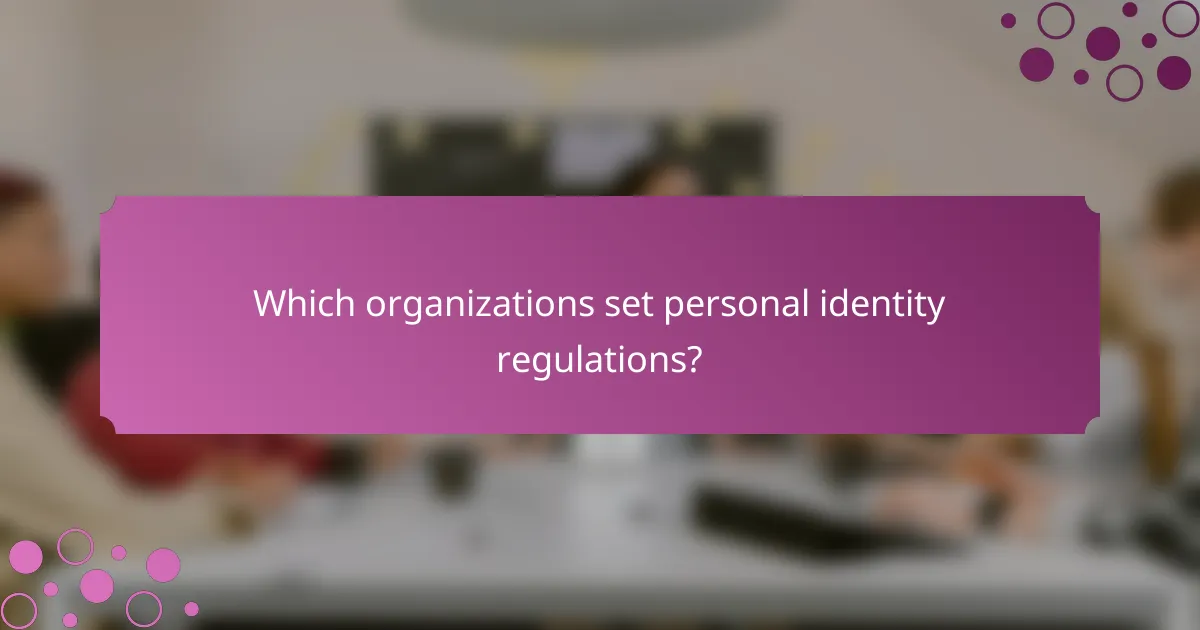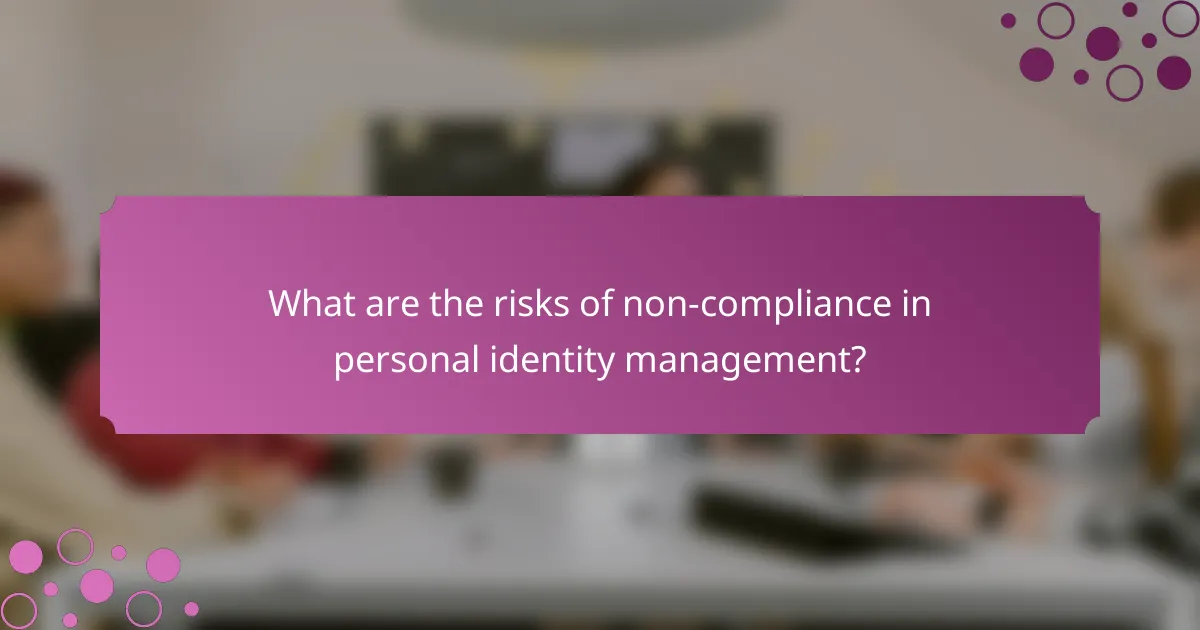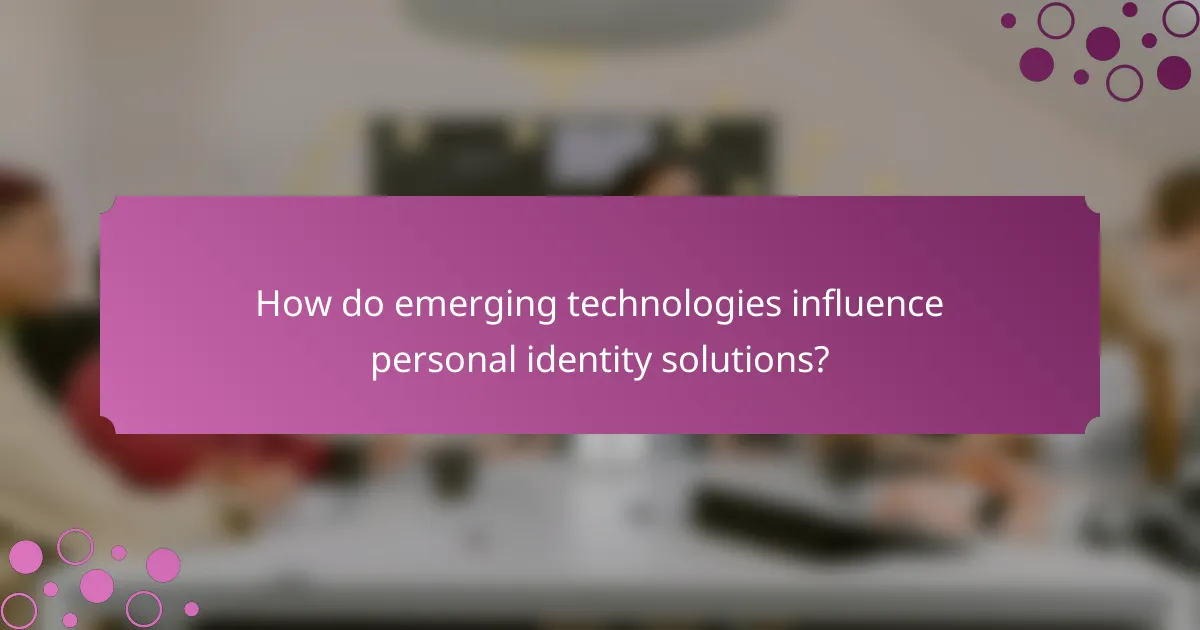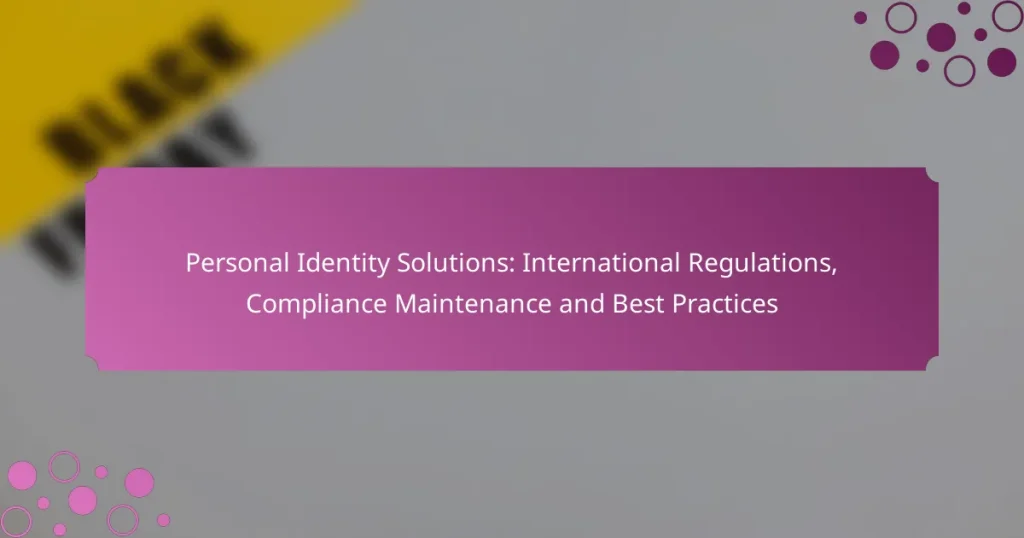Personal identity solutions are increasingly influenced by international regulations that dictate data protection and privacy standards. To ensure compliance and foster user trust, organizations must adopt best practices focused on data security and user consent management. Continuous monitoring and employee training are essential strategies for maintaining compliance and adapting to evolving legal frameworks.

What are the best practices for personal identity solutions in the UK?
The best practices for personal identity solutions in the UK focus on ensuring data security, maintaining compliance with regulations, and effectively managing user consent. Implementing these practices helps organizations protect personal information while fostering trust with users.
Data encryption techniques
Data encryption is essential for safeguarding personal identity information. Techniques such as AES (Advanced Encryption Standard) and RSA (Rivest-Shamir-Adleman) are widely used to encrypt sensitive data both at rest and in transit. Organizations should ensure that encryption keys are managed securely to prevent unauthorized access.
Additionally, using end-to-end encryption for communications can further protect user data. Regularly updating encryption protocols to comply with evolving standards is crucial to maintaining security.
Regular compliance audits
Conducting regular compliance audits is vital for organizations handling personal identity data. These audits help identify gaps in compliance with regulations such as the UK General Data Protection Regulation (GDPR). A thorough audit should assess data handling practices, security measures, and user consent processes.
Establishing a schedule for audits, such as annually or bi-annually, can help ensure ongoing compliance. Organizations should document findings and implement corrective actions promptly to address any identified issues.
User consent management
Effective user consent management is crucial for compliance with data protection laws in the UK. Organizations must obtain clear and informed consent from users before collecting or processing their personal data. This can be achieved through transparent privacy policies and consent forms that outline data usage.
It is important to provide users with easy options to withdraw consent at any time. Regularly reviewing and updating consent mechanisms can help ensure they remain effective and compliant with legal requirements.

How do international regulations impact personal identity solutions?
International regulations significantly shape personal identity solutions by establishing legal frameworks that govern data protection and privacy. Compliance with these regulations is essential for businesses to avoid penalties and maintain consumer trust.
GDPR compliance requirements
The General Data Protection Regulation (GDPR) mandates strict guidelines for the handling of personal data within the European Union. Organizations must ensure that they have a lawful basis for processing personal data, which can include consent, contractual necessity, or legitimate interests.
Key requirements include the right to access personal data, the right to rectify inaccuracies, and the right to erasure. Businesses should implement data protection by design and by default, ensuring that privacy measures are integrated into their processes from the outset.
To maintain compliance, companies should regularly conduct data protection impact assessments (DPIAs) and appoint a Data Protection Officer (DPO) if necessary. Non-compliance can lead to fines of up to 4% of annual global turnover or €20 million, whichever is higher.
CCPA implications for businesses
The California Consumer Privacy Act (CCPA) provides California residents with specific rights regarding their personal information, impacting how businesses collect and manage data. Under the CCPA, consumers have the right to know what personal data is being collected, the purpose of its collection, and the ability to opt-out of the sale of their data.
Businesses must implement processes to respond to consumer requests and provide clear privacy notices. Failure to comply can result in penalties ranging from $2,500 to $7,500 per violation, emphasizing the need for robust compliance strategies.
Companies should consider training staff on CCPA requirements and regularly reviewing their data practices to ensure transparency and accountability. Establishing a clear privacy policy and maintaining open communication with consumers can help mitigate risks associated with non-compliance.

What are the key compliance maintenance strategies?
Key compliance maintenance strategies include continuous monitoring systems and employee training programs. These approaches help organizations stay aligned with international regulations and maintain effective compliance over time.
Continuous monitoring systems
Continuous monitoring systems are essential for ensuring compliance with regulations. These systems track changes in laws and internal policies, providing real-time updates that help organizations adapt quickly. Regular audits and assessments can be integrated into these systems to identify potential compliance gaps.
When implementing a continuous monitoring system, consider using automated tools that can analyze data and flag discrepancies. This reduces the risk of human error and enhances efficiency. For example, financial institutions often use software that monitors transactions for compliance with anti-money laundering regulations.
Employee training programs
Employee training programs are crucial for maintaining compliance and fostering a culture of awareness within an organization. Regular training sessions can help staff understand relevant regulations and their roles in compliance efforts. This is particularly important in sectors with stringent regulatory requirements, such as finance and healthcare.
To maximize the effectiveness of training programs, use a mix of formats, including workshops, e-learning modules, and hands-on exercises. Regularly update training materials to reflect changes in regulations and best practices. A common pitfall is neglecting to assess employee understanding, so consider implementing quizzes or feedback sessions to gauge knowledge retention.

Which organizations set personal identity regulations?
Several key organizations establish regulations for personal identity management, focusing on data protection and privacy. These regulations aim to safeguard individual rights while ensuring compliance across various jurisdictions.
European Data Protection Board
The European Data Protection Board (EDPB) is responsible for ensuring consistent application of data protection laws across the European Union. It provides guidance on the General Data Protection Regulation (GDPR), which sets strict rules on personal data handling and privacy rights.
Organizations operating within the EU must comply with GDPR standards, which include obtaining explicit consent for data processing and ensuring data subjects can access and control their information. Non-compliance can result in significant fines, often reaching up to 4% of annual global turnover.
Information Commissioner’s Office
The Information Commissioner’s Office (ICO) is the UK’s independent authority set up to uphold information rights. It enforces the UK General Data Protection Regulation (UK GDPR) and the Data Protection Act, providing resources and guidance for organizations on compliance.
Organizations in the UK must ensure they follow ICO guidelines, which include maintaining transparency about data usage and implementing adequate security measures. The ICO also offers a range of tools, such as self-assessment checklists, to help businesses navigate compliance effectively.

How to choose a personal identity solution provider?
Choosing a personal identity solution provider involves assessing their compliance with regulations, evaluating their technology, and ensuring they meet your specific needs. Focus on their ability to maintain security, privacy, and user experience while adhering to international standards.
Evaluation criteria checklist
When evaluating personal identity solution providers, consider a checklist that includes security features, compliance with regulations like GDPR or CCPA, scalability, and user experience. Assess whether the provider offers robust authentication methods, data encryption, and regular security audits.
Additionally, look for integration capabilities with existing systems and platforms. A good provider should support various APIs and have a flexible architecture to accommodate future growth.
Vendor reputation analysis
Vendor reputation is crucial in selecting a personal identity solution provider. Research their history, customer reviews, and case studies to gauge their reliability and performance. Look for feedback on their responsiveness to issues and their track record in maintaining compliance with relevant regulations.
Consider reaching out to current or past clients for firsthand insights. A provider with a strong reputation in the industry is more likely to deliver a secure and effective solution that meets your identity management needs.

What are the risks of non-compliance in personal identity management?
Non-compliance in personal identity management can lead to significant legal and financial repercussions, as well as damage to an organization’s reputation. Understanding these risks is crucial for maintaining compliance and protecting both individuals and businesses.
Legal penalties
Failure to comply with personal identity management regulations can result in severe legal penalties, including hefty fines and sanctions. For instance, organizations that violate data protection laws, such as the General Data Protection Regulation (GDPR) in Europe, may face fines that reach up to 4% of their annual global turnover.
Additionally, non-compliance can lead to lawsuits from affected individuals or regulatory bodies. This not only incurs legal costs but can also result in enforced changes to business practices, which can be both time-consuming and expensive.
Reputation damage
Non-compliance can severely damage an organization’s reputation, leading to a loss of customer trust and loyalty. When customers learn that their personal information has been mishandled or compromised, they are likely to seek services from competitors, resulting in decreased revenue.
Moreover, negative media coverage surrounding compliance failures can have long-lasting effects. Companies may find it challenging to recover their public image, which can take years to rebuild, impacting future business opportunities.

How do emerging technologies influence personal identity solutions?
Emerging technologies significantly enhance personal identity solutions by improving verification processes and increasing security. Innovations like blockchain and artificial intelligence streamline identity management while reducing the risk of fraud.
Blockchain for identity verification
Blockchain technology provides a decentralized and tamper-proof method for verifying identities. By storing identity information on a distributed ledger, individuals can control their data and share it securely with authorized parties.
Implementing blockchain for identity verification can reduce costs associated with traditional identity management systems. Organizations can lower expenses related to data breaches and identity fraud, which can run into thousands of dollars per incident.
AI in fraud detection
Artificial intelligence plays a crucial role in detecting fraudulent activities related to personal identity. By analyzing patterns in user behavior and transaction data, AI systems can identify anomalies that may indicate identity theft or fraud.
To effectively utilize AI for fraud detection, organizations should ensure they have access to high-quality data and continuously train their models. Regular updates and monitoring can help maintain accuracy and adapt to evolving fraud tactics.

What are the future trends in personal identity solutions?
Future trends in personal identity solutions focus on enhanced security, user-centric designs, and compliance with evolving regulations. Innovations such as biometric authentication and decentralized identity systems are gaining traction, aiming to provide safer and more efficient identity verification processes.
Increased use of biometric authentication
Biometric authentication is becoming a standard practice in personal identity solutions, leveraging unique physical traits like fingerprints, facial recognition, and iris scans. This method enhances security by making it difficult for unauthorized users to gain access, while also streamlining the verification process.
Organizations should consider implementing biometric systems that comply with local regulations, such as the General Data Protection Regulation (GDPR) in Europe, which mandates strict data handling practices. Additionally, users may prefer biometric methods for their convenience, as they often require less time than traditional password systems.
Decentralized identity systems
Decentralized identity systems are emerging as a way to give users more control over their personal information. These systems allow individuals to manage their identities without relying on a central authority, reducing the risk of data breaches and identity theft.
Implementing decentralized identity solutions involves using blockchain technology to create secure, tamper-proof records. Organizations should evaluate the feasibility of adopting such systems, considering factors like user adoption rates and integration with existing infrastructure.
Regulatory compliance and data privacy
As personal identity solutions evolve, compliance with data privacy regulations is crucial. Organizations must stay informed about local laws, such as the California Consumer Privacy Act (CCPA) or the EU’s GDPR, which impose strict guidelines on data collection and usage.
To maintain compliance, companies should conduct regular audits of their identity management systems and ensure that they have robust data protection measures in place. Training employees on data privacy best practices is also essential to mitigate risks associated with non-compliance.


